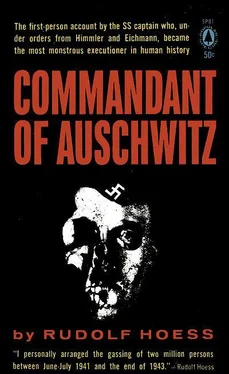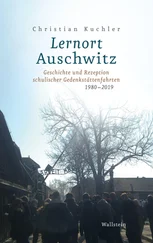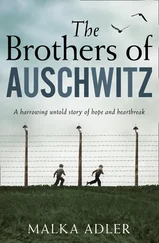I guessed at the time that this was happening, but was reluctant to believe it.
But today I can see the picture more clearly.
I have now described what was the true and only background to it all, the dark shadows that lay behind the concentration camps.
Thus the concentration camps were intentionally, though sometimes unintentionally, transformed into huge-scale extermination centers.
The Reich Security Head Office issued to the commandants a full collection of reports concerning the Russian concentration camps. These described in great detail the conditions in, and the organization of, the Russian camps, as supplied by former prisoners who had managed to escape. Great emphasis was placed on the fact that the Russians, by their massive employment of forced labor, had destroyed whole peoples. For example, if, during the construction of a canal, the inmates of one camp were expended, thousands of fresh kulaks or other unreliable elements would be produced, who after a time would be expended in their turn.
Was the purpose of these reports to accustom the commandants gradually to their new task? Or was it to render them insensitive to the conditions gradually developing in their own camps?
As DI one of my regular jobs was to undertake distasteful inquiries in the various concentration camps, and even more often in the work camps. These were not always pleasant for the commandants. I was also responsible for the necessary changes in personnel, as for example at Bergen-Belsen. Up till then the Inspectorate of Concentration Camps had paid no attention to this camp. It was used by the Reich Security Head Office mainly for the so-called “delicate” Jews, and it was only regarded as a temporary transit camp. The commandant, Sturmbannführer Haas, a grim, taciturn man, directed and governed the place as he saw fit. He had actually been for a time at Sachsenhausen, in 1939, as commander of the protective custody camp, but he came from the General SS and had not much knowledge of concentration camps.
He made no attempt to improve the state of the buildings or the grim hygienic conditions prevailing at Bergen-Belsen, which was an old prisoner-of-war camp taken over from the army. He had to be relieved of his post in the autumn of 1944 because of the way he neglected the camp and carried on with women, and I had to go there and install Kramer, previously commandant of Auschwitz II, in his place. [90]
The camp was a picture of wretchedness. The barracks and the storerooms and even the guards’ quarters were completely neglected. Sanitary conditions were far worse than at Auschwitz.
By the end of 1944 it was no longer possible to do much in the way of building, although I managed to extract a most capable architect from Kammler. We could only patch up and improvise. Despite all his efforts, Kramer was not able to rectify the results of Haas’s negligence. Thus when Auschwitz was evacuated, and a large proportion of the prisoners came to Bergen-Belsen, the camp was at once filled to overflowing and a situation arose which even I, accustomed as I was to Auschwitz, could only describe as dreadful. Kramer was powerless to cope with it. Even Pohl was shocked when he saw the conditions, during our lightning tour of all the concentration camps which the Reichsführer SS had ordered us to undertake. He at once commandeered a neighboring camp from the army so that there would at least be room to breathe, but conditions there were no better. There was hardly any water, and the drains simply emptied into the adjoining fields. Typhus and spotted typhus were rampant. A start was immediately made on the building of mud huts, to provide additional accommodation. [91]
But it was all too little and too late. A few weeks after our visit the prisoners from Mittelbau began to arrive, so it was little wonder that the British found only dead or dying or persons stricken with disease, and scarcely a handful of healthy prisoners in a camp that was in an unimaginably disgusting condition. [92]
The war, and above all the war in the air, produced a cumulative effect on all the camps. Each new shortage as it appeared caused a further deterioration in their general condition. The building of work camps in connection with important armaments projects—always rush jobs—suffered particularly on account of such shortages and dislocations.
The air war and the bombing attacks on the armaments factories caused countless deaths among the prisoners. Although the Allies did not attack any concentration carnp, as such, that is to say the actual protective custody camp, yet prisoners were employed in all the more important war factories. They thus shared the fate of the civilian population.
From the beginning of the intensified air offensive in 1944, not a day passed without casualty reports being received from the camps as a result of air raids. I cannot give a rough estimate of the total number, but it must have run into many thousands. I myself lived through plenty of air attacks, usually not in the safety of a “hero’s cellar.” Attacks of unprecedented fury were made on factories where prisoners were employed. I saw how the prisoners behaved, how guards and prisoners cowered together and died together in the same improvised shelters, and how the prisoners helped the wounded guards.
During such heavy raids, all else was forgotten. They were no longer guards or prisoners, but only human beings trying to escape from the hail of bombs.
I myself have passed unscathed, though often badly shaken, through countless raids. I have seen the bombs rain down on Hamburg and Dresden and often on Berlin. I once escaped certain death during an accident in Vienna. On the journeys which formed part of my duties, my train was often subjected to low-level air attack. The Economic Administration Head Office and the Reich Security Head Office were repeatedly hit with bombs, but were always patched up again. Neither Müller nor Pohl would let themselves be driven out of their offices. The homeland too, or at any rate the larger towns, had become the front line. The total number of lives lost as a result of the air war can certainly never be calculated. In my estimate it must be several millions. [93]
The casualty figures were never made known, and were always kept strictly secret.
I am constantly reproached for not having refused to carry out the Extermination Order, this gruesome murder of women and children. I have given my answer at Nuremberg: what would have happened to a group captain who refused to lead an air attack on a town which he knew for certain contained no arms factory, no industrial plant of value to the war effort, and no military installations? An attack in which he knew for sure that his bombs must kill principally women and children? He would surely have been court-martialed. People say that this is no comparison. But in my opinion the two situations are comparable. I was a soldier and an officer, just as was that group captain. Some say that the Waffen-SS was not a military organization, but a kind of party militia. However, we were just as much soldiers as were the members of the other three armed services.
These perpetual air attacks were a heavy burden on the civilian population and especially on the women. The children were evacuated to remote districts, free from the threat of air raids. The effect was not only physical—the whole life in the big towns was thrown into confusion—but also and to a very great extent psychological.
Careful observation of the faces and the demeanor of the people in the public shelters or in the cellars of their homes revealed their mounting nervousness and fear of death, as the onslaught approached and the bomb carpet came closer. How they clung to each other, wives seeking the protection of husbands, as whole buildings shook or began to collapse.
Читать дальше












